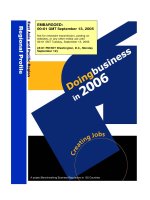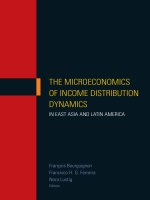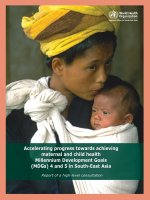south east asia development 1a pptx
Bạn đang xem bản rút gọn của tài liệu. Xem và tải ngay bản đầy đủ của tài liệu tại đây (1.55 MB, 37 trang )
Economic Development of
Southeast Asia
Ian Coxhead
University of Wisconsin-Madison
1
Overview
Week 1: Early modern development
Historical background – initial conditions
Getting growth started: resources, industry, agriculture
“Old style” global shocks: oil crisis, 1970s
Income growth, poverty and distribution
Week 2: Development since mid-1980s
Post-Plaza Accord boom, bubble and bust
Globalization, again: trade liberalization and FDI
Enter the dragon: the rise of China
Topics: human capital, Asian regional integration, macro
policy
2
Approach and assessment
Lots of reading!
Thinking about what we read:
2 short midweek homeworks @ 10%
Connections to data
1 big research assignment, using SE Asian economic growth
and development data @ 30%
Just checking…
2 end-of-week tests @ 20%
Having your say
Class participation @ 10%
3
1a Southeast Asia before the
modern era
4
5
6
Overview
Why study “ancient” history?
Precolonial SE Asia: the first globalization era
Colonialism
War, nationalism and revolution
The region about 1970: a snapshot
map
7
Why study ancient history?
Precolonial SEA has some remarkable similarities with contemporary
times:
Resource endowments relative to rest of world
Natural resource abundance
Importers of advanced technologies
Trade relationships
Esp. predominance of China & Northeast Asia
Vulnerability to world market shocks
Susceptibility to radical political and religious ideas
Of course, some differences too:
Then: labor shortage; now, mainly labor abundance relative to rest of
world
Is history fate?
map
8
Precolonial SE Asia (~1000-1600 AD)
Mainland, Java, Sumatra: centralized kingdoms with capitals
astride navigable rivers
Wealth based on local resource base and taxes on resource exports
(rice, spices, specialty timbers)
E.g. Ayuthaya (Thailand): about 25% gov’t revenue from taxes on
trade between hinterland and rest of world.
Major religions display strong centralizing tendencies
Archipelago/Malay peninsula: decentralized political entities,
capitals at coastal ports
Wealth based on resource exports and entrepôt trade between Red
Sea ports, India and China
Spread of Islam (a decentralized religion) along maritime trade
routes
9
10
11
Resource endowments
Labor-scarce, land-abundant economies
Slavery & quasi-slavery systems widespread & persistent
Many wars were primarily slave raids
Corvée and indentured labor under colonialism.
Open land frontiers (these weakened central authority)
Natural resource wealth
Abundant timber and cropland, plentiful & regular rainfall
Specific resource endowments of very high value (nutmeg, mace,
cloves, tin & other mineral resources)
Little reproducible capital and few commercial inst’ns
Main unit of production was the household
Manufactures and high-tech products largely imported (ceramics,
silk & painted textiles, navigational eqpt, paper)
12
Precolonial globalization
Trade with China, India, & Europe
Maritime Silk Route
European search for “Spice Islands” voyages of discovery
Columbus (1492), De Gama (1498), Magellan (1521), …
Migration and cultural flows accompanied trade
Specialization & technology transfers
European trade huge expansion of pepper & spice area,
intraregional trade in rice & other staples
Vulnerability to global shocks
Trade shocks: closure of China & Japan; European conflicts
Dependence of global trade routes on small numbers of entrepreneurs
(or on foreign MNCs, e.g. Dutch E. India Co.)
13
14
15
Summary: precolonial SE Asia
Resources: land abundance, labor scarcity.
Trade: diversified; regional and global.
Econ. structure: mainly diversified; subsistence-oriented;
low-tech (no capital).
“Southeast Asia … has always been an exporter of raw materials and an
importer of manufactures. Its own manufactures were significant items
of local trade, but … they were not needed in China or India, the two
populous manufacturing centers on its borders. It was the products of
tropical agriculture and horticulture… that received the greatest stimulus
from the trade boom… followed by forest products”
(Reid 1993:32).
16
Colonialism (17
th
century to ~1950s)
Econ. motives for colonial rule
Trade access to East Asia (Manila, Cochinchina as
bases/entrepots)
SE Asian natural resources (spices, timber, ag. produce,
minerals)
Treaty of Breda (1697): Dutch exchange an American colony
for Run Is., securing global monopoly on nutmeg
Trade and tax revenues to support colonial govt
Markets for European manufactures.
Strategic and political motives also important
inter-Euro competition for markets & influence (Portugal vs.
Venice, etc.).









